Purchase and Sale Items (2nd Page)
The items of articles and services, which are the content of the sales order (purchase order), are entered on the 2nd page of the document. Subordinate documents are created for these items here. The items are displayed in the rows one underneath another. We can change their displayed order by clicking on the column header according to which the items are to be sorted. More information about the order is described in the Re-Sorting of Document Items chapter.
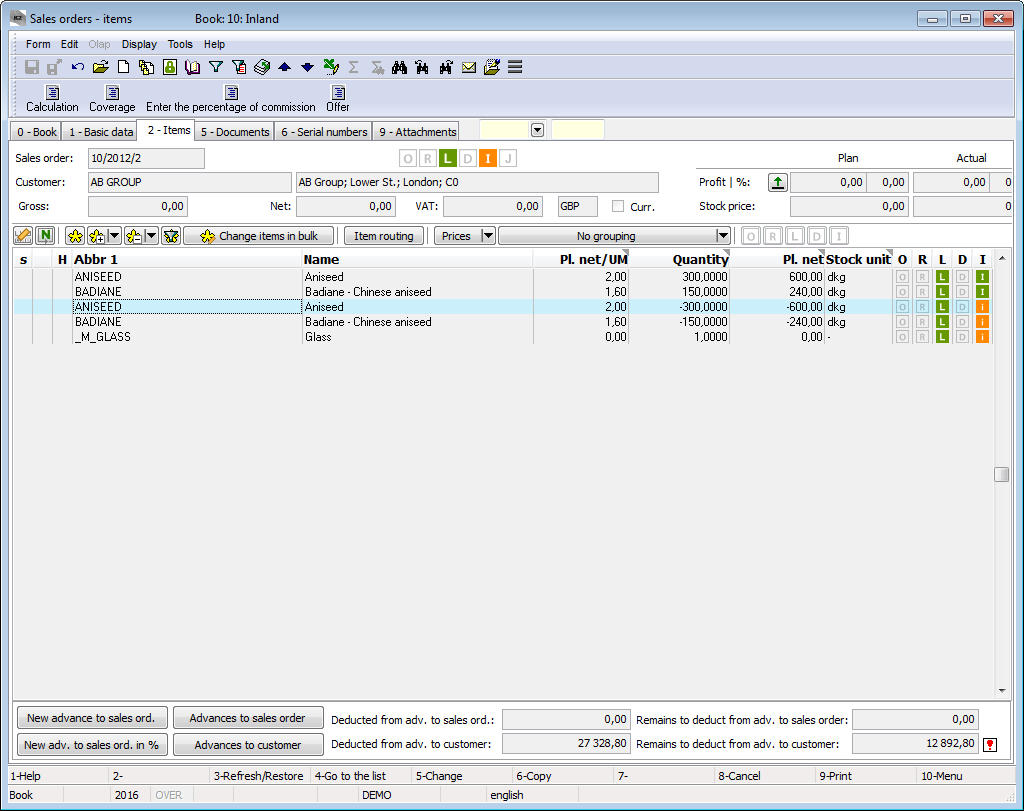
Picture: Sales Orders - 2nd page
Description of elements from the panel for the work with items
|
Button to activate the Edit Rows function. The Edit Rows mode enables to edit the values directly in the rows of items without the necessity to open the form of the item. You can change values in the columns with the dark filled upper right corner of the heading. The editing is executed in the Changemode by pressing the Enter key in the field that you want to change. Press the Enter key again to enter the executed change. If the Edit Rows mode is active, you can open the item form, when necessary, by pressing the Ctrl+Shift+Enter key combination. |
|
The button to activate the Repeat Inserting of Items option. Pressing the button can speed up your work by automatically appearing a new form to insert a new item after each saving a new item. It is not necessary to press the Ins key repeatedly. Note: The functionality is independent of the value of the user parameter Repeat Inserting of Items. This parameter does not apply to purchase and sales documents. |
|
Button to mark an item. |
|
Button for (cancelling) marking of all items. When pressing the button,
Picture: the criterion for selecting an item with a list of sales documents
|
|
The button for displaying only the marked items. |
Bulk Change of Items |
It allows you to change data in the document items in bulk, including applying a set discount from the Customer card. The further description of this function is stated in the Bulk Change of Document Items chapter. |
Item Routing |
It serves to display a routing variant of a marked item of a product or of a semi-product. |
Prices |
Switching prices.
|
Grouping |
Items may be grouping in the Browse Mode. Items can be grouped by these criteria:
Note: When grouping items, the grouping is cancelled when switching between documents. |
Buttons to create documents (e.g. |
Buttons to create / cancel subordinate documents for items. |
If a discount is entered into the item of Purchase or Sale Document (to the planned or invoiced price), its flag will appear in the "S" column on the 2nd page of the document ![]() . A discount of a negative value means a surcharge (in the "S" column, a flag appears
. A discount of a negative value means a surcharge (in the "S" column, a flag appears ![]() ). The entered discount is automatically copied into the other inserted item.
). The entered discount is automatically copied into the other inserted item.
From the 2nd page of documents (which have a Tax Summary), it is possible to switch to the Tax Summary tab on the 1st page by using the Alt+C key combination.
Re-sorting Items of Document
Re-sorting items is executed in the Change mode on the 2nd page of the documents. Following keys are used for the re-sorting:
Grey Plus and Grey Minus |
By using the light indicator, scroll between the selected items up and down. Items with the identical ID ("OrigItem” field; item split) are moved together, it is not possible to either change their order nor insert another item between them . |
Shift+F3 |
After pressing the keys, the Sorting of Items form that offers the re-sorting of any of the linked documents appears. Select the document and click on the Sort Items by Selected Document button. Flags for change are created at the re-sorted items. New sorting has to be saved. |
field # |
Changing the order of items can also be done by writing the desired number into the field # on the form Purchase / Sale Item. |
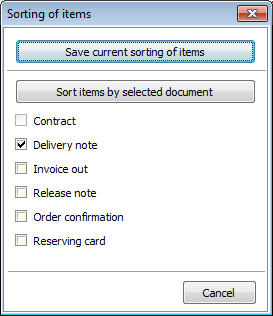
Picture: Sorting of Items
The document items can also be sorted according to any column by clicking on its header. If you are in the Change mode, you can saved the sorted items by using the Save Current Sorting of Items button in the Sorting of Items form which is called by the Shift+F3 key combination.
Data of Purchase and Sale Items
Display the form of a Purchase (Sale) Item by pressing Enter key on an already existing item on 2nd page of document or purchase and sale. The identical form is also displayed when setting a new item into a document by pressing Ins key.
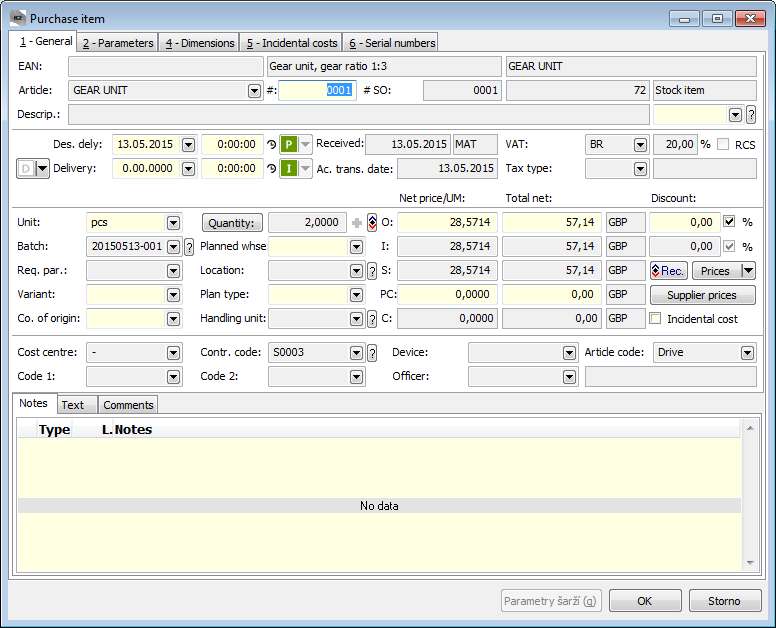
Picture: The Purchase Item form - General tab
Tab GENERAL
Field Description:
EAN |
Field for an additional bar code. If you set it, a name of article and the next data from an Article card including the units that relate to the EAN will be automatically entered to the form. |
Articles |
The content of this field keeps changing depending on a type of sorting in the goods table. Sorting can be: Abbr 1, Abbr 2, Number and Name. It is possible to switch the sequencing in this field by the means of the A1(A2) button. The button will display if we have, in the Purchase and Sale documents tool bar, the icon |
Description |
Additional Name (from the Language supplements book). It enables to assign different supplements to each document item. Note: Content of the field is displayed in the Item Name and is printed on documents if the Do Not Display Article Names option is checked on an Article card that is selected on an Item. |
# |
Item order number in a given document. This number can be derived from a superior document, but it can also be edited according to the current or any other document (via the Re-sort ItemsShift+F3 function). The number may also be changed by a direct record into the item form. |
# Sales Order # Purchase Order |
Number of an item on a superior document. |
Required (Purchase) |
The data from the fields for date and time are copied from the Delivery Date in the document header. If the entry is changed in the item, it has a priority over the heading entry. You can change the Date up to the time you confirm the Delivery time on the Item. |
Delivery (Purchase) |
The field contains the Delivery Date of the given goods confirmed by the contractor. It is filled from the Required field when creation Delivery Confirmation. |
Required (Sale) |
The data from the fields for date and time are copied from the Delivery Date in the document header. If the entry is changed in the item, it has a priority over the heading entry. You can change the Date up to the time you confirm the Received Order on the Item. |
Confirmed on (Sale) |
The date and time to which we confirm the delivery of goods to our customer. It will be completed with the Requested field value in the case of a new item. The value of the field will change when the Requested field value is changed in the situation when both the fields have the same value, or when the Confirmed On field is null. Confirming a Purchase Order will deactivate the field. The user may enter it in the form of the Sale Item in universal forms. |
Reserv. (Sale) |
The Fields (Date and Time) express the inner date to that create a Reserving card (RC). When creation the entry from the Required field is copied here, but it can be changed up to the time of confirmation the Reserving Card. |
Dispatch (Sale) |
Date and time of dispatch of goods. It is not completed automatically. Confirming a Delivery Note will deactivate the field. The user may enter it in the form of the Sale Item in universal forms. |
Acc. Trans. Date |
Account transaction date from an Invoice. |
Unit |
For setting the Stock Unit from Article card. The stock unit that has the Default Unit option checked for a module is automatically set at a new item (e.g. Default Unit for Sale). |
Batch |
It serves to insert the batch of received or released articles. The field is available if there are recorded batches for the article (option Batch Records on an Article card). |
Req. param. |
Required parameters of batch. The field is accessible only if the Article card has defined at least one parameter with the enabled Value from Batch value (internally the Batch type exists for the card). Subsequently create the so called Requested Parameters (heading) in the book of Requested Parameters and define concrete parameters with theirs values. |
Variant |
In this field you can set a Routing Variant of a product or a subassembly. When creation the Job Cards from the Sales Order Items, the Job cards are created on this Routing Variant by the Dispatcher function. (If it is not set, it is going to be created for the Default Routing Variant). When confirmation an inferior Reserving Card document, the Variant of an item cannot be changed. In purchase, the variant is blocked by confirmation an inferior Delivery confirmation document. |
Country of orig. |
The value is copy from Article card in Purchase. In Sale, it is necessary to set it by the user. |
Guarantee (m.) (Sale) |
The length of guarantee stated in months. The field is used to consider the type of service (Guarantee/Post-Guarantee) if the case of creating a Service Sheet over a Sale Item. |
Price Group (Sale) |
The input field for the item price group definition. This entry is copied from a source item or from heading of a document depending on setting in the User Parameter when creation an item. The price group, according to which the result price of the item was defined, can also be displayed here depending on the parameter, or the result price can be displayed (when using Base Price). The icons are displayed next to the Price Group field for easier orientation in the origin of the selling price on item. The icons are directly related to the utilization of price creation options, similarly to the data in the Price Group field. The Price creation is described in the 5th page of Article card chapter, eventually in the Creation of prices in the K2 IS methodology.
|
Quantity |
For the quantity definition in the appropriate unit. It is set on 1 at a new item. You can execute the setting of the negative quantity by the minus key or by the If a selected Article card has set the multidimensional quantity (see the methodology), the Multidimensional quantity form for setting the required values is displayed when pressing the Quantity button. |
Plan. whse |
A warehouse for which receipt/release of the given item is planned. A stock document for this warehouse will be created later. |
Location |
Used for more detailed registration of articles in stock (for example their location in racks). The field is available if there is a location defined for the article (option Location Records on an Article card) and if the stock for the article is known (the stock from a stock document header or a Planned Warehouse defined on the item). |
Handling Unit |
The field serves to insert the batch of received or released goods. A handling unit is one of the dimensions of auxiliary stock record (batch, location, contract code, handling unit). The field is accessible if there are handling units recorded on the respective stock (option Handling Unit Recordson a Stock card). The obligation of a handling unit in the case of recording handling units in stock: when saving a stock document, a non-filled in unit is considered to be non-defined (i.e. blocking of articles regardless of the handling unit); when confirming the document, a non-filled in unit is considered to be non-entered (movement without the unit). |
Supplier (Sale) |
Selection of a supplier from whom the given articles are bought. It is intended for particular business companies. By pressing the question mark next to this field, the list of suppliers to who the price is assorted on the 4th page of an Article card is displayed. |
Plan type |
The Selection from a Plan type code list. The field takes the value from the header and may be edited there. |
VAT |
The VAT rate can be changed until an Invoice is confirmed. |
RCS |
The flag is checked on items to whom the tax type with the RCS mode flag on is applied. Such item is considered to be an item without the VAT even though the VAT flag is checked in the document header (with the exception of tax invoices). It is not possible to change the field. |
Tax Type |
A tax type can be changed until an Invoice is confirmed. It will be completed from an Article card (although it is empty on the Article card). Tax type from an item takes precedence over the tax type in a document header. |
Prices |
Prices enable to enter a unit or the total price of an item. Upon any change of one price, the other one is changed automatically. The price per a unit of measurement does not contain the sign. The total price contains the sign according to the Credit Note. Ctrl+Alt+B keys switch between the Net (without VAT) and Gross (with VAT) prices. Ctrl+Alt+M keys enable to switch among currencies in heading of document. |
Net/UoM Price |
Price for a selected stock unit. |
Total Net |
The total price of a unit. |
O (Purchase) |
The Sales Order and Delivery Note price. If the Invoice is unconfirmed, the price will be copied also to the Invoice price. When inserting an Item, the Last or Purchase price is pre-filled according to setting in the User Parameters. It is automatically blocked by confirmation the document of Delivery confirmation. |
F (Purchase) |
The Invoice price. |
S (Purchase) |
Price of a Receipt card - Net Stock Price. When inserting an item the Planned Stock Price is entered here from an Article card. The price is without any purchase costs that can be defined on the Article card. Also a Price form a supplier's price list can be entered here. It corresponds to the 'F' price after confirmation the Invoice. In case of releases on a Receipt card, the appropriate price according to the methodology of pricing a warehouse will be entered when confirmation a Receipt card. When confirmation a Receipt card on a warehouse that is kept at fixed prices, the price is updated according to the planned stock price on an Article card. Note: You can display an Actual Stock Price as a column on the second page of documents (Actual Stock Price - a stock price with the secondary costs - in case of activated Stock Price with Incidental Costs client parameter). |
PIC (Purchase) |
Planned incidental costs. The eventual purchasing costs defined on an Article card in the Purchasing Costs field will be inserted after entering a new item. If there are no existing actual incidental costs (the C field) and the user has the Purchase / Items / Change Planned Incidental Costs right, this field may be manually edited. Planned costs may also be allocated into items via the function Allocate Incidental Costs. If there are no existing actual incidental costs (the C field), the stock price (StkPr) is calculated as S+PIC. |
C (Purchase) |
Actual incidental costs. These may be assigned to an item only via the function Allocate Incidental Costs by allocating the amount from the source document. A closer description of this is provided in the chapter Allocating Incidental Costs in Purchase. If an item contains actual incidental costs, the letter 'C' is in bold. Actual incidental costs take precedence over planned incidental costs for the calculation of stock prices (S+C). |
A (Sale) |
The price of a Sales Order, an Order and a Delivery Note. If the Invoice is unconfirmed, the price will be copied also to the Invoice price. When setting, change of amount or of a price group, it is entered according to the Selling price form an Article card. It is automatically blocked by confirmation a Delivery Note or an Order In. |
I (Sale) |
The Invoice price. |
R (Sale) |
The price of a Reserving Card - Planned Stock Price. Upon inserting a new item, the stock price is submitted from the Article card. |
S (Sale) |
The price of a Release Note - Actual Stock Price. Upon inserting a new item, the stock price is submitted from the Article card. It is submitted for the releases according to stock price category upon confirming a Release Note (sliding price, fixed price, according to batches). The price is updated also by the Stock Recalculation function (in the case of a sliding price, the sliding price valid to the release date will be inserted). |
S (Sale) |
The Catalogue Price, i.e. the base selling price from the 5th page (upper part) of an Articlecard in the time of creating of the document. Its display can be suppressed by the user parameter. |
Discount (planned) |
It is possible to give a discount in an absolute value or as a percentage (according to checking the % field). |
Discount (invoiced) |
It is possible to give an invoiced discount in an absolute value or as a percentage (according to checking the % field). |
Switch |
By pressing the The identical icon is used for the State of Origin field. The value of the field from the Article card is also reloaded. |
Prices |
This button works as a switch between displaying prices in Gross and Net values or to display the original prices (before a discount) and prices after a discount. |
Gross/Net |
A switch for displaying prices in values of Gross and Net (Ctrl+Alt+B). |
Original Prices/Prices with Discount |
A switch for displaying original prices (before a discount) and prices after a discount (Ctrl+Alt+O). |
Supplier prices (Purchase) |
Supplier prices - book Input into the form. The record are by default filtered for the suppliers from heading of a document. You can load the data from price list into the purchase item by selecting from records and by confirmation the selection by pressing Enter key. The supplier price will be entered into all prices of the item. Records in the supplier Prices can be edited, copied or newly created (data from the purchase item are offered). See the detailed description in the Supplier prices (4th page) chapter. This button works only in Change mode. |
Incidental Costs |
The activated option indicates an item that is considered as an incidental cost. You can predefine it for specific article items in the Article Category. The option is useful in the Allocation of Incidental Costs in Purchase function. |
Contract Code |
Selection from a Contract Codes code list. The field is obligatory. Its value is automatically entered from the header of a document, eventually from an Article card if set. If it is not filled in, it will be done so from the document header. |
Article Code |
Selection from an Article Codes code list. If entered in an Article card, it will be inserted automatically. If it is not filled in, it will be done so from the document header. |
Cost Centre |
Selection from code list of Cost Centres. The field is obligatory. Its value is automatically entered from the header of a document, eventually from an Article card if set. If it is not filled in, it will be done so from the document header. |
Device |
Reference to the Device book. If entered in an Article card, it will be inserted automatically. If it is not filled in, it will be done so from the document header. |
Code 1 |
Another additional code. If entered in an Article card, it will be inserted automatically. If it is not filled in, it will be done so from the document header. |
Code 2 |
Another additional code. If entered in an Article card, it will be inserted automatically. If it is not filled in, it will be done so from the document header. |
Code 3, Code 4, Code 5, Code 6 |
Further additional codes. Code 3 to Code 6 are not available by standard. If the user wishes to use those codes, they must activate them (see ....). The codes may be made available only in the universal resolution. If entered in an Article card, it will be inserted automatically. If it is not filled in, it will be done so from the document header. |
Officer |
Reference to the Officers book. If entered in an Article card, it will be inserted automatically. If it is not filled in, it will be done so from the document header. |
Item ID |
Item number on the given document. This number can be derived from a superior document, but it can also be edited according to the current or any other document. You can overwrite this number directly in the Purchase / Sale item form only if the Lock Items ID field is not checked on the 2nd page of the document. This number is displayed in #xxx (e.g. #001) format on a printed document. |
Item ID of Sales Order / Purchase Order |
Number of an item on a superior document. |
You can insert Notes to the Purchase and Sale Items but only in Change mode of a document or in a New record. Press the Alt + * keys to display the Notes tab. The light indicator will be indicated directly in Notes. Press the Alt+- keys for switching on the Text tab. Use the Alt+/ keys for switching on a following tab (eventually from the last tab to the first). Further description of work with the notes is also provided in the chapter Basic Code Lists and Supporting K2 Modules – Notes.
It is possible to insert commentaries to Purchase and Sale items. Further description of work with the commentaries is also provided in the chapter Basic Code Lists and Supporting K2 Modules – Comments.
The button Batch Parameters is used to filter batch parameters of the selected articles. Detailed description of work with it is provided in the Function for Batches Over Article Database chapter.
Tab PARAMETERS
This folder tab serves as an overview of batch parameters and required parameters of a given item.
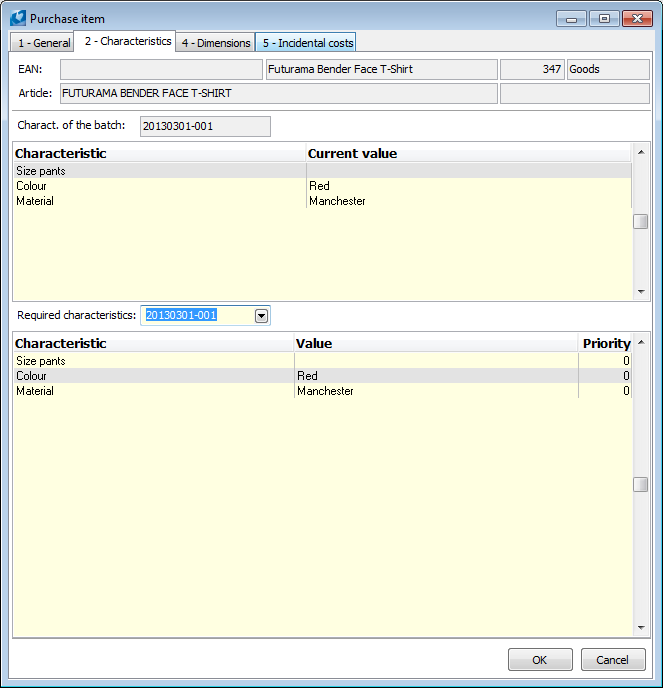
Picture: The Sale Item form - Parameters tab
In the upper table are defined the parameters (actual) of a batch of an item (the batch abbreviation is displayed in the Parameters of Selected Batch).
At the bottom of the table there are stated the required parameters of an item (a record of required parameters is entered in the Required Parameters field).
Example: In the picture, you may see that we have required 'Buttons' for ordered trousers; however, the actual delivery (batch) contains the value "Zipper" for the "Closure" parameter.
Tab SUBORDINATE
If there is a Job card issued for certain article, it will appear in this folder tab window.
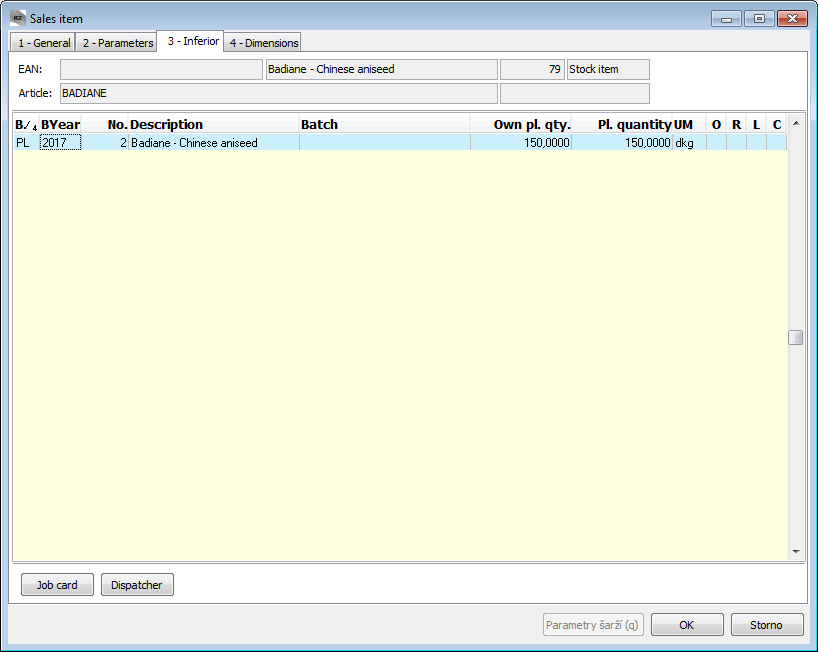
Picture: The Sale Item form - Subordinate tab
Switch to the Book of Job Cards via the Job Card button with the light indicator set to this particular Job card. By using the Dispatcher button, we get to the module of production planning. (We can get back to the tab by using the Esc key.)
Tab DIMENSION
This tab serves as an overview of selected information on certain item, the way they are entered in the stated locations – card of customer, document header, and article card. (The fields for item available to edit are linked with data in the General tab.)
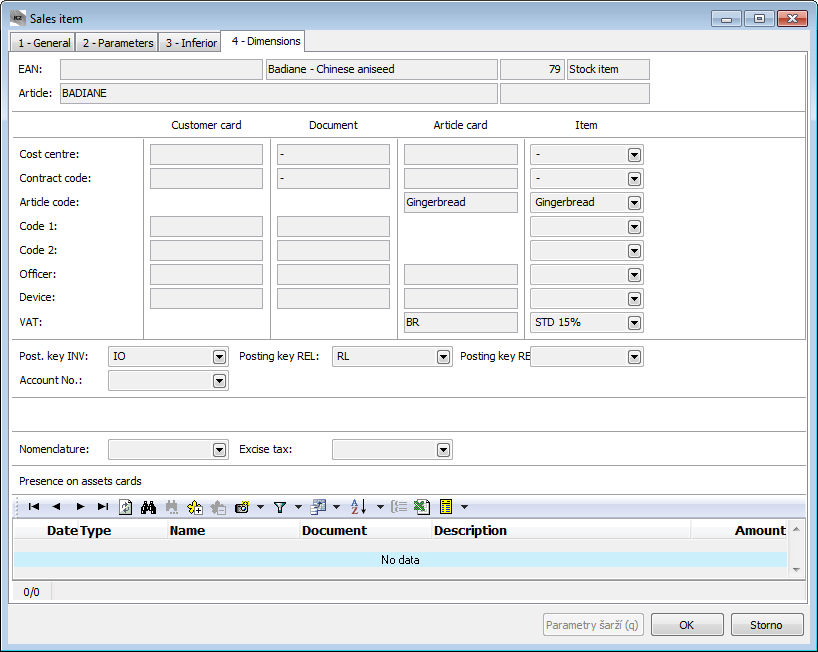
Picture: The Sale Item form - Dimension tab
Select a Posting key for Invoice, Release Note and Reserving Card type from the book of Posting Keys for Posting Key I, Posting Key V and Posting Key R. We may select a required account number from the Chart of Accounts in the Account Number field, and in the Matching Symbol field, we can select a matching symbol to which the given item will be accounted. The Nomenclature and Excise Tax fields must be filled in if the given item is subject to calculation of excise tax.
The Document for Deduction checkmark on a Purchase Item is pre-filled in the item if the supplier has checked the checkmark on the first page of the book Suppliers - Employs an employee with a disability. The checkmark was used to create an attachment to substitute compliance within the Substitute Handicapped Regulations Compliance - it is not being used since 2018, as the compliance is reported by the provider.
The Substitute Compliance checkmark on the Sale Item is activated if the compliance is provided in the Substitute Compliance mode.
Cards of Asset that are linked with the given item are displayed in the Occurrence on Cards of Asset part.
Tab SERIAL NUMBERS
Serial numbers of an item are inserted in this folder tab. The tab shows for those articles only that have a register of serial numbers.
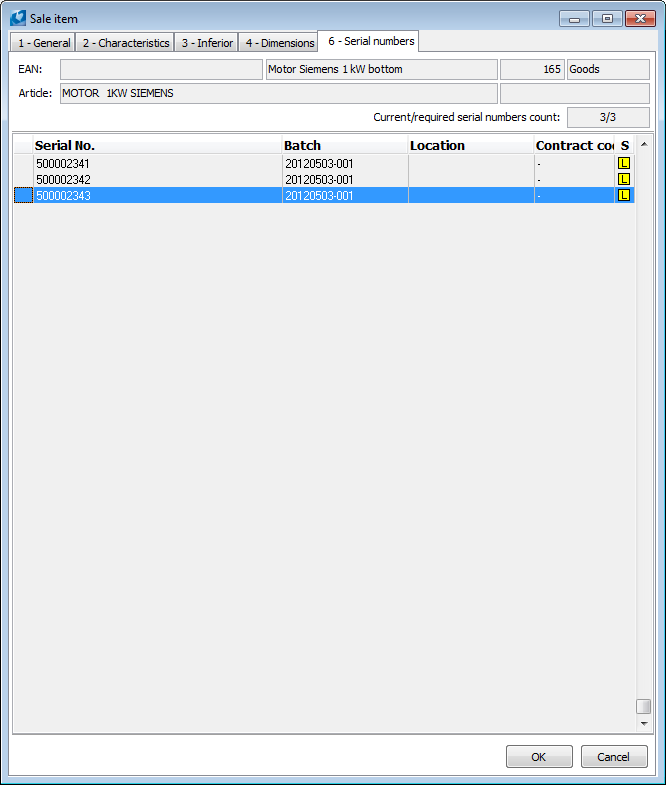
Picture: The Sale Item form - Serial numbers tab
Tab INTRASTAT
The information for reporting to Intrastat are recorded in this tab. This tab is accessible only in Invoices Out and In if the given document does not have the Do Not Include Into Intrastat flag checked in the document header.
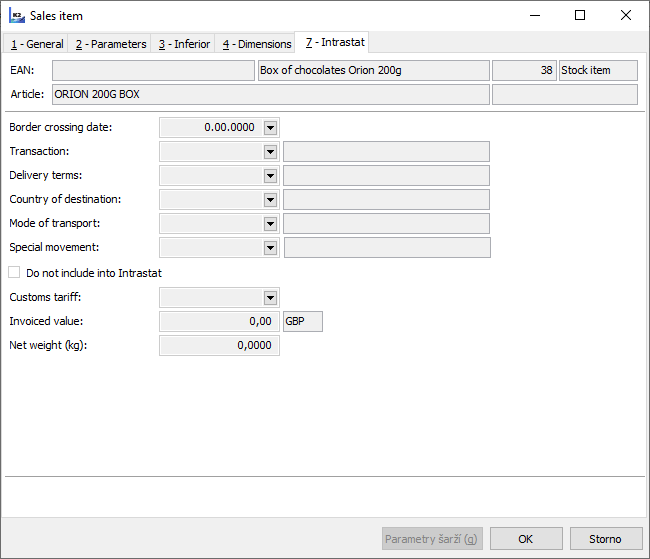
Picture: The Sale Item form - Intrastat tab
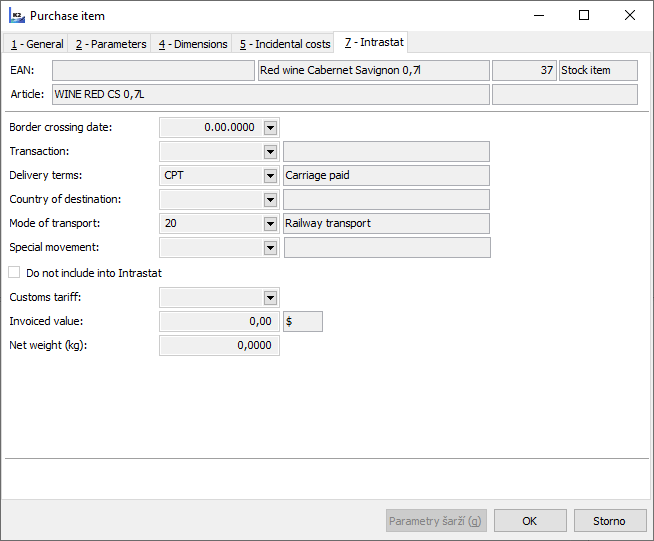
Picture: The Purchase Item form - Intrastat tab
Field Description:
Border Crossing Date |
If the border crossing date in the item differs from the date set in the Invoice header, the date will be entered here. This value takes precedence over the value of the field of the same name in the Invoice Out (Invoice In) heading. |
Transaction |
If the item has a transaction code that is different from the one in the Invoice header or the value in Intrastat Parameters, the value will be entered here. |
Delivery Terms |
If the delivery terms of the item are different from those in the Invoice header or the value in Intrastat Parameters, the value will be entered here. |
Country of Destination / Country of Dispatch |
If the country of destination (of an Invoice Out) on the item is different from the one in the invoice address, the country of destination will be entered here. If the country of dispatch (of an Invoice In) on the item is different from the one in the invoice address, the country of destination will be entered here. |
Mode of Transport |
If the mode of transport of the item is different from the one in the Invoice header in the Mode of Transport code list or the value in Intrastat Parameters, the value will be entered here. |
Special Movement |
Special movement code. |
Do Not Include into Intrastat |
If this field is checked, the document item will not enter Intrastat. |
Define and Change Items in Superior Document
Insert New Items
We select new items that we insert to a superior document with the Insert key from the the Article book. That way you submit a completely new item to a Sales Order (Purchase Order). After the Insert key, the form Sale (Purchase) Item will open. You may enter detailed information about the new item in this form.
When you insert the article items as well as the items other than goods to a superior document, VAT is automatically submitted to every article from the Article database. When trying to paste an invalidated article, the system displays a query about whether you really wish to paste an invalid article. A VAT rate will be inserted to a new item from an Article card according to the date on the document (with regard to the document in which it is being created):
- Sales Order - VAT rate is filled in according to the Delivery Date,
- Purchase Order - VAT rate is filled in according to the Desired date.
Methods concerning pasting a new item can be different, as it depends on user configuration in the User Parameters (detailed description in the User Parameters chapter).
- If the parameter Open Book of Articles When Inserting an Item is active, pressing the Insert key will display the article menu, and only after the selection, we insert more data of the Purchase/Sale form.
- The parameter Repeat Inserting of Items will automatically open this form again after closing the Purchase/Sale Item form. Close the selection of articles with Esc.
- The option Edit Rows in the document heading enables to choose article with the Ins key and directly return to the document. The column Quantity will automatically become available and we may write in the desired quantity of an item. By pressing the Enter key and writing in the value, we may edit all the other columns that enable manual entry. This concerns the columns with a filled in right upper corner in the heading. You may open the whole Purchase/Sale Item form with the Ctrl+Shift+Enter combination for eventual necessary correction of other values. This option together with the parameter Repeat Inserting of Items significantly facilitates and speeds up inserting items into a document.
Bulk Insert Items
The items may be added to documents in bulk by using the Shift+F6 keys. The form of bulk inserting is divided into two parts: the upper part represents a book of Articles where we select items, and the bottom part represents the second page of the document, where the selected items are displayed. Select an item in the upper part of the open form, press Enter (this will activate the column Quantity), write in the desired quantity and confirm with the Enter key again. The item in the desired quantity will be inserted into the document (and will be displayed also in the bottom part of the form). Items may also be added to documents from Article books via bulk inserting of records from a container, respectively the records marked with asterisks. To do this, we can use the button Paste from Container button in the bottom bar. In this case, the item quantity will be set to 1. If the option Insert Entire Avail. Quantity is active, the items will be pasted in the entire available quantity in stock. At the same time, the allocation of items according to batches will occur. Close the form for bulk inserting with the button Close, the keys Ctrl+Enter or with Esc. The written items will be copied to a Sales Order/Purchase Order.
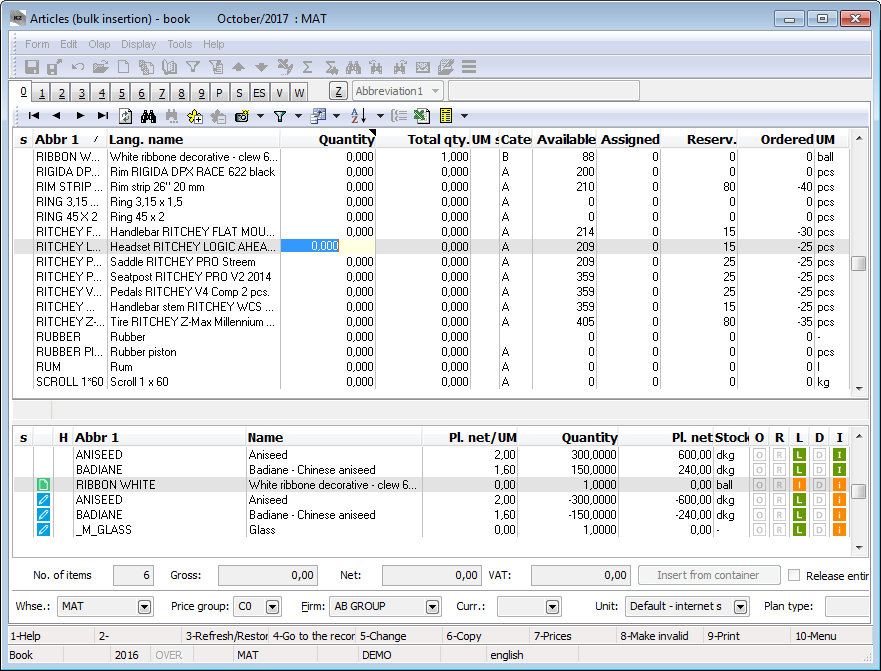
Picture: Bulk Insert Items on the 2nd page of document
In universal forms, bulk inserting of items from a container, respectively those marked with an asterisk, is done via the option Insert Selected. This enables to enter various quantity to items in a document via sub-options.
- Insert Quantity One: inserts quantity to items = 1;
- Insert Entire Avail. Quantity into Items: items will be inserted in the entire avail. quantity in stock, and subsequently will be allocated according to the contract codes;
- Insert Entire Coverage Quantity: sets the respective quantity to items which matches their coverage level (the Coverage Level field (CoverageLevelUMCalc) in the Article book).
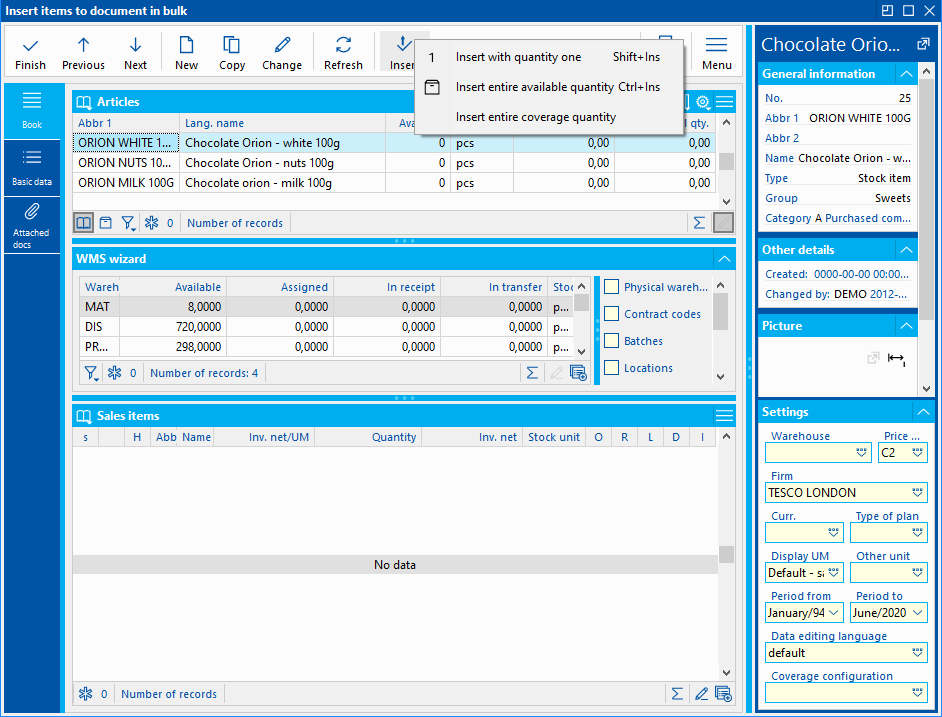
Picture: Bulk Insert Items on the 2nd page of document - universal forms
- You may also insert items in bulk into the document Sales Order via the Insert key. This may be done after activating the Bulk Insert Items into Sales Order user parameter.
Change Item
Data of the items of a superior document may be edited and corrected in the Change mode any time. We can enter the Purchase/Sale Item form via using the Enter key.
Change of some fields may be prohibited depending on the subordinate documents confirmation. For instance, if we have a confirmed subordinate document, we cannot change the items Article, Article Code, Cost Centre, Code1, Code2 and Officer. If we have a confirmed Invoice, we cannot change the 'I' price, etc.
If no subordinate document has been confirmed, it is possible to change the quantity of the given item to a random value (also to increase it), and this quantity will be changed at all subordinate documents.
If the VAT rate or a Tax Type is changed on an item, the tax summary of the Invoice, the VAT amount, and the Gross amount will be recalculated in the subordinate documents.
Delete Item
Delete the items of a Sales Order (Purchase Order) by using the Del key. An item will not be deleted immediately but it will be checked by a red checkmark at the beginning of the row. The actual deleting will be finished after saving a Sales Order (Purchase Order) via the F2 key. If we press the Del key on an item highlighted this way before the saving, the checkmark will be removed and the item will not be deleted.
If you delete an item from a superior document, the item will be actually deleted and thus also deleted from all subordinate documents. If at least one subordinate document has been confirmed, the deletion will not be executed.
Define and Change Items in Subordinate Document
Insert New Items
We also insert items to a subordinate items also with the Insert key, but this will open the table Header Items. This table contains all the items corresponding to the Sales Order or the Purchase Order for which the appropriate subordinate document has not been created yet. However, the system will not allow to insert an item whose Article Category prevents it by its settings - more in Article Categories, such items are not displayed at all during the selection from a superior document.
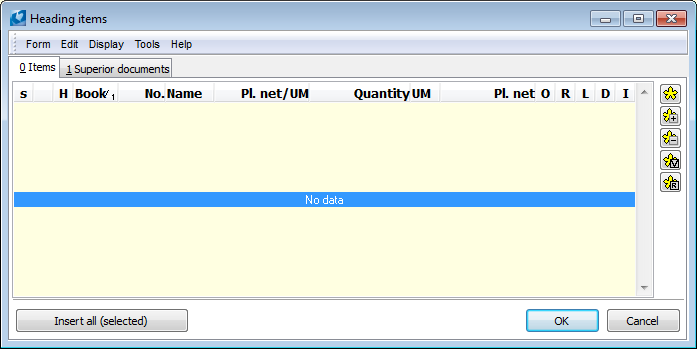
Picture: Header Items book
We may also enter a completely new item into a subordinate document via the F6 key; such item will automatically be inserted into the superior document. A VAT rate will be inserted to a new item from an Article card according to the date on the document (with regard to the document in which it is being created):
- Order Confirmation, Delivery Note, or Delivery Confirmation - VAT rate completed according to the Delivery Date,
- Invoice Out, Invoice In - VAT rate completed according to the Account. Trans. Date,
- Release Note, Receipt Card, Reserving Card - VAT rate completed according to the Date of Issue.
You may also use bulk insert via Shift+F6 described in the chapter Insert New Items to Superior Document. Items inserted this way will automatically be added also in the superior document if the user has the right to change the superior document. If the user does not have the right, the form will not appear and the user is informed by a query about restricted access.
Change Item
By pressing the Enter key on a selected item in the Change mode, you may edit the individual data of the item the same way as when editing an item in a superior document.
Upon issuing a subordinate document, you cannot define higher quantity of the articles than the one that has been defined in the superior document. It is possible to reduce the quantity in the subordinate document, which will split the original item of the superior document into two new items. The first item will be issued for the quantity of the respective subordinate document, and the other item will contain the rest of the articles without any indication of the respective subordinate document.
Example: We have ordered 25 pcs of chairs. The supplier will deliver only 15 pcs, which will be immediately invoiced. A Receipt Card is issued for the 15 pcs. Later on, the supplier sends another 5 pcs with an additional Invoice for 5 pcs. The remaining chairs will stay held in thePurchase Order as 'non-delivered'. Three new items under the same name will be stated in the Order instead of the original one, but with different flags.
Delete Item
You can delete an item from a subordinate document by using the Del key, while this item will be deleted immediately. This item will remain in existence in the the Sales Order (Purchase Order), only the flag of the respective subordinate document will be changed.
Change Article Card on a Document Item
After changing an Article card on a Purchase and Sale item, a query will appear: "Do you want to keep values from the original item?":
- "No" - the item will be completed from a newly entered Article card with Cost Centre, Contract Code, Article Code, Device, Code 1, Code 2, Officer, Alternative Unit, Prices, Country of Origin,
- "Yes" - the values of the above mentioned fields will not update.
Further fields such as Item Name, Batch, Guarantee, VAT rate, Tax Type will always be updated when changing an Article card.
Bulk Change of Document Items
If we wish to change a value in several items at once, we can use the Bulk Change of Items button on the 2nd page of Purchase and Sale documents. The changes can be done in the Change mode. An exception is Invoices in and Purchase orders, where values of Intrastat may be changed in both items and Browse mode(also on confirmed invoices).
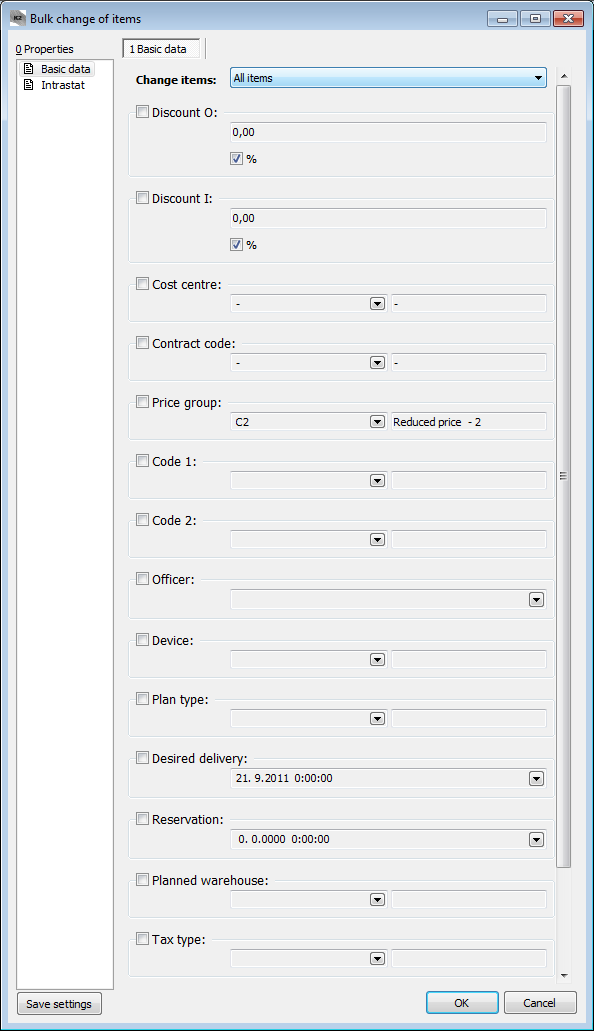
Picture: The Bulk Change of Articles form
The user can adjust the range of items they wish to change (all, current, marked, etc.) in the upper part. The "Blank" option stands for a blank value, which means that the change will be performed only on those items whose changed fields are empty.
It is always necessary to check the fields we wish to change, then the values we wish to save to the given places will become available. For a frequent change of the same fields we may use the Save Settings option, which always sets the activation of options as it was saved before when opening a new form. The change in items in called by the OK button, then it is necessary to save the changes in the document. Pressing the Cancellation button closes the form for changes without making or saving any changes. Only those changes to which the user has an access right are always made.
Note: When running the form, the value from a currently selected item is completed into the values of individual fields. The value entered in the the field Percentage Discount from the selected customer is pre-filled into the Discount Z and Discount F fields.
In the case of calling the form over an Invoice In or Out in the Change mode , the form contains two tabs: change of Basic Data and change of data in Intrastat. If the form is called over the Invoices in Browse mode, the form offers only the option to change the Intrastat data.
Multi-documents
Multi-documents serve as an option to add several superior documents to one subordinate document in Purchase and Sale. A subordinate document may be an Invoice In, a Receipt Card, an Invoice Out, a Release Note, etc. For example, several contracts can be settled by one Invoice Out.
You can check the parameters Enable Superior Document to Be Included from Another Book or Enable to Add Superior Document with different Suppl./Cust. on the tab 2 - Trade in the Client Parameters. The meaning is thereof clear from their name.
It is possible to create mult-idocuments only in a subordinate document with a linked superior document. Furthermore, there cannot be the same subordinate document from which you want to create a multi-document on the items which should be attached from another superior document. For example, it is not possible to attach items from another Sales Order to a Release Note if these items are already in another Release Note (either confirmed or unconfirmed). A multi-document cannot be created from documents with a different VAT calculation method either.
The procedure for creating a multi-document is as follows:
- Press the Ins key on the 2nd page of a subordinate document in the Change mode. This will display the form Header Items with two tabs.

Picture: The Header Items - 0 Items form
- On the tab 0 Items will appear all the items from superior documents that are displayed on the 1 Superior Documents tab (see below) and that do not have a created subordinate document yet. We may insert the individual items without marking them via the OK button. If we wish to insert more items, we can use the Insert All (Selected) button. If no items are selected, all of them are entered to the document. If we want to add only some of them, we indicate them with the so-called asterisks, while we may also, apart from the standard buttons, use the icons
 and
and  , which are used to mark all the items with a a confirmed Release Note or a Reserving Card. We may find a similar icon in Purchase for items with a a confirmed Receipt Card.
, which are used to mark all the items with a a confirmed Release Note or a Reserving Card. We may find a similar icon in Purchase for items with a a confirmed Receipt Card.
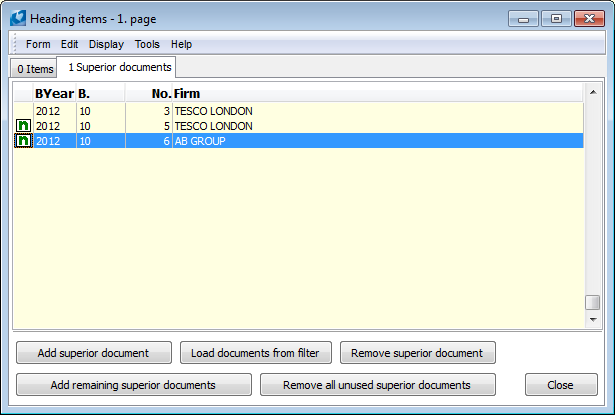
Picture: The Header Items - 1 Superior Documents form
- On the 1 Superior Documents tab, the main superior document that is linked with its respective subordinate document and the superior documents that we add here are displayed here. Insert a new superior document via the Ins key, or via the Add Superior Document button. A book with superior documents will open. We can select the document that we wish to attach by using the Enter key.
Meaning of the other buttons in the form:
Remove Superior Document |
This removes a superior document from the form and at the same time cancels the link between the removed document and the subordinate document. However, the items which belong to the superior document must be removed from the subordinate document beforehand (via the Delete key; subsequently, the change must be saved). |
Remove All Unused Superior Documents |
All superior documents which have none of their items attached to the given subordinate document will be removed, and the unused links will be cancelled. The function is available in the saved document. |
- After inserting items from another superior document into the subordinate document, the column 'H' will display the flag
 at each such item, which will inform us that the item is from a different superior document. In the item pasted, it is possible to change quantity, price, etc. For example, if a note has been entered in the item concerned, and if you enter smaller quantity in the Invoice, this note remains maintained on both items (in the Invoice and in the superior document). The programme treats the given item the same way as any other item.
at each such item, which will inform us that the item is from a different superior document. In the item pasted, it is possible to change quantity, price, etc. For example, if a note has been entered in the item concerned, and if you enter smaller quantity in the Invoice, this note remains maintained on both items (in the Invoice and in the superior document). The programme treats the given item the same way as any other item.
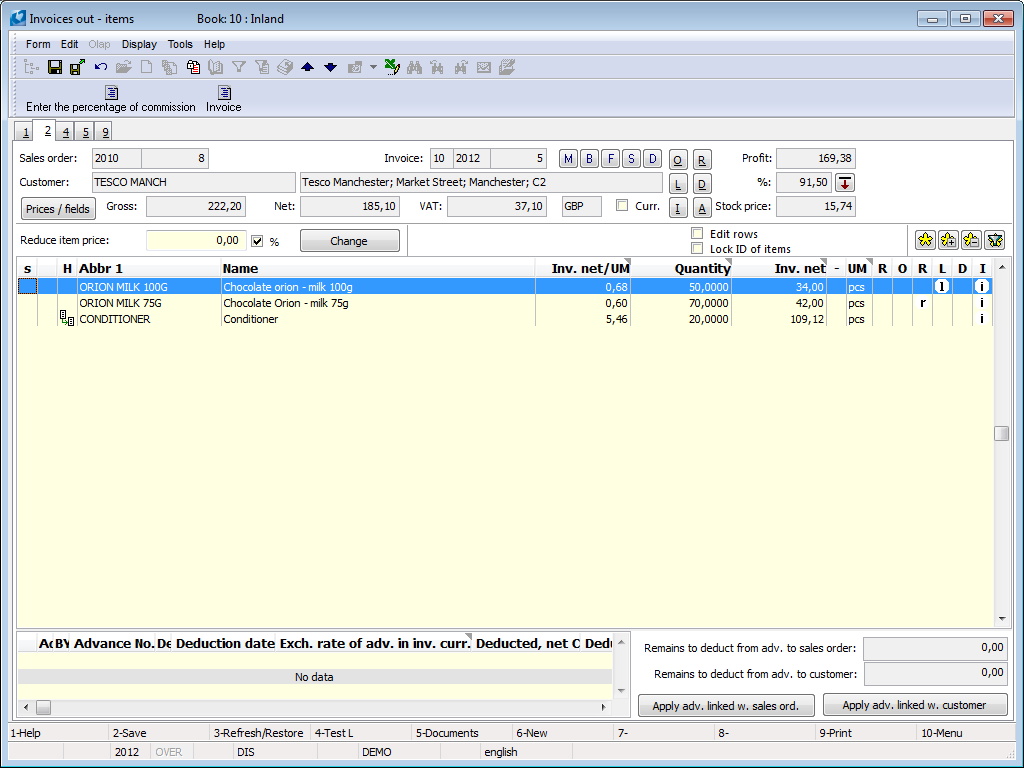
Picture: An Invoice Out with more Sales Order
Note: If the parameter Prefer Sorting of Subordinate Documents is off in multi-documents, the items will be sorted according to the ID from a superior document. This sequence cannot be changed in other way than by sorting it according to some of the columns or by re-saving the items via the Shift+F3 keys.
Excise Taxes
The data necessary for calculation of excise taxes in the documents of Purchase and Sale, i.e. the 6-digit code for tax return and excise tax rate, are copied from an Article card into a Purchase and Sale item when selecting an Article card. Both pieces of data may be found on the Dimension tab and it is possible to change them.
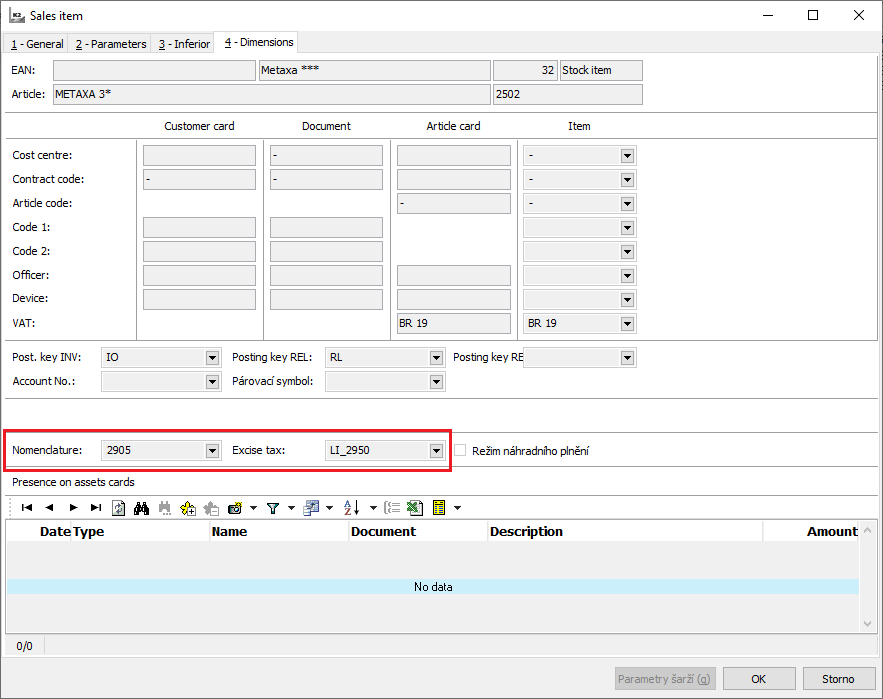
Picture: The Purchase Item- tab Dimension - the data necessary for the calculation of excise taxes
Individual types of excise taxes may be distinguished with the Abbreviation of an excise tax rate. The first two characters of the Abbreviation always define the type of the excise tax, the other characters are arbitrary. When defining a new rate of an excise tax, we create the Abbreviation in the following steps:
excise tax type |
first two characters of the Abbreviation of the excise tax type |
excise tax on mineral oils |
MO |
excise tax on alcohol |
AL |
excise tax on wine and intermediate products |
WI |
excise tax on beer |
BE |
excise tax on tobacco products |
TP |
The amount of an excise tax is calculated in an Invoice Out, Invoice In and a Release Note, and only if the field Excise Tax is checked on the 1st page of the document. When saving the document, the amounts of excise taxes will be calculated according to the data defined in the Purchase and Sale items (quantity on the General card and an excise tax rate on the Dimension card), and also in the Article card (concentration). The amount of excise tax is saved into the excise tax summary, which may be displayed on the 1st page of an Invoice Out or an Invoice In in the Excise Tax tab.
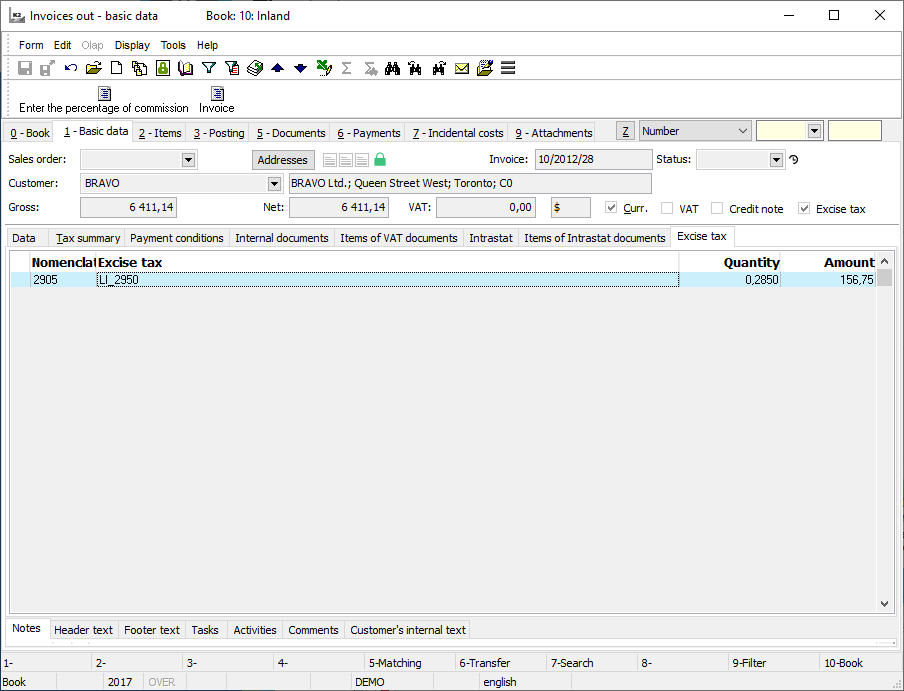
Picture: Invoice Out - tab Excise Tax - excise tax summary
Additional Functions
Functions' description:
F4 |
In Sale, you can test the possibilities of submitting the item to a Release Note, resp. Reserving Cards (for Sales Orders and linked subordinate documents). The key is functional in both the Change mode and in a New record. If we insert the Sales Order items into Release Notes, a testing of articles will begin after pressing the F4 key. The present item might split into two new items - for the articles that are in stock a new Release Note will be created, and a Reserving Card for the rest of the articles will be created. This function may be used for example after copying a Sales Order which had items with flags of release - the flags of the items are copied, and we may correct them by testing the availability. |
F5 |
Used in the Change mode to bulk insert items into selected subordinate documents or to delete these items from the documents. |
F6 |
Inserts a new item for linked subordinate documents in the Change mode. |
Alt+F10 |
Select stocks for stock documents in the Change mode and in a New record. |
Ctrl+Enter |
Opens a form on a Purchase (Sale) item which enables to browse the articles of the given item. |
Shift+F3 |
Enables to rewrite the numbers (ID) of items according to the current classification or according to the order in another document (corresponding to the same superior document). |
Shift+F4 |
The same use as F4 - testing the options of release is possible for one item only. |
Shift+F5 |
Coverage of articles per customer. |
Shift+F6 |
Insert items to documents in bulk. |
Ctrl+Shift+F8 |
Enables to create a new Service Sheet from a Sale item with a new Service Order, or to attach this new Service Sheet to an already existing Service Order. The only condition is to have the Complaints / Service parameter on. |
It is possible to create more documents into the documents in the Change mode if we press the Alt+letter of document flag button on the selected item. We may also turn the flags on and off with mouse by clicking on the buttons in the document heading. If the flag in an subordinate document is deactivated, the appropriate item is aborted.
Document Flags:
I |
Invoice |
D |
Delivery Note (Delivery Confirmation) |
P |
Receipt Card |
V |
Release Note |
R |
Reserving Card |
O |
Purchase Order |
These flags may also be activated directly in the Purchase (Sale) Item form.

 ,
, 